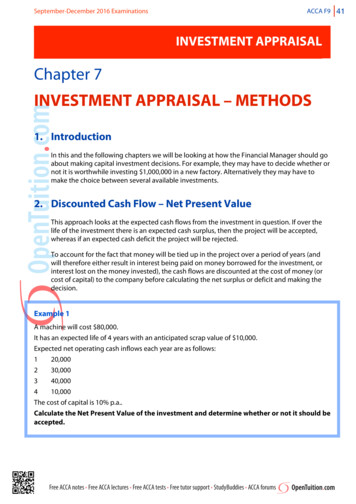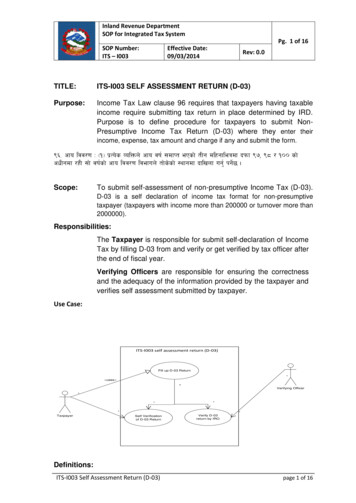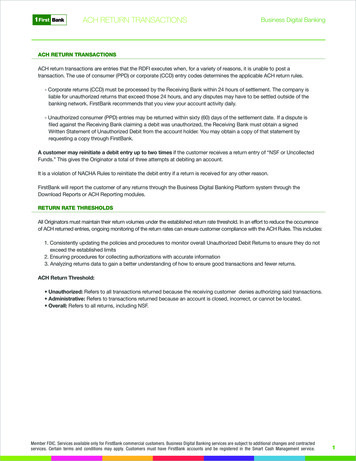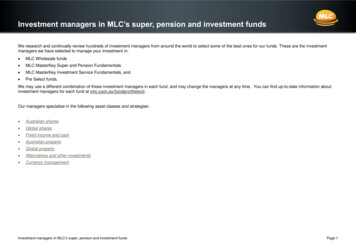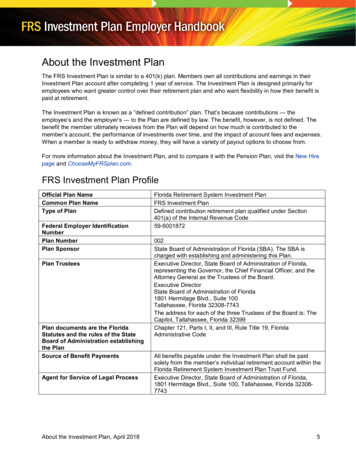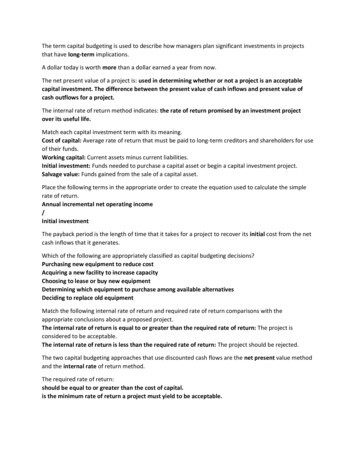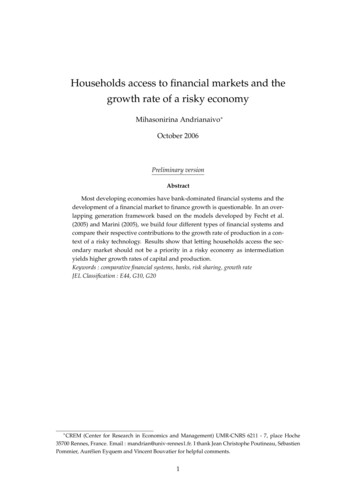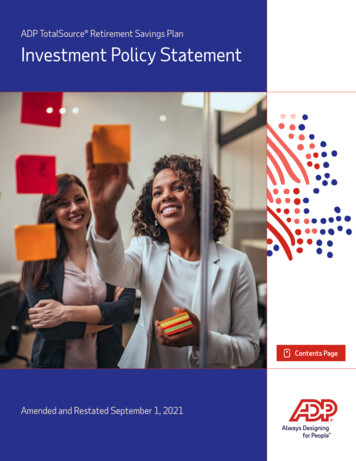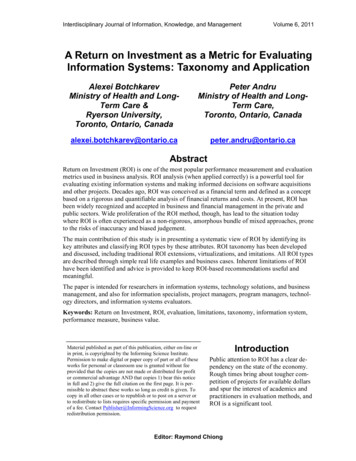
Transcription
Interdisciplinary Journal of Information, Knowledge, and ManagementVolume 6, 2011A Return on Investment as a Metric for EvaluatingInformation Systems: Taxonomy and ApplicationAlexei BotchkarevMinistry of Health and LongTerm Care &Ryerson University,Toronto, Ontario, CanadaPeter AndruMinistry of Health and LongTerm Care,Toronto, Ontario, rio.caAbstractReturn on Investment (ROI) is one of the most popular performance measurement and evaluationmetrics used in business analysis. ROI analysis (when applied correctly) is a powerful tool forevaluating existing information systems and making informed decisions on software acquisitionsand other projects. Decades ago, ROI was conceived as a financial term and defined as a conceptbased on a rigorous and quantifiable analysis of financial returns and costs. At present, ROI hasbeen widely recognized and accepted in business and financial management in the private andpublic sectors. Wide proliferation of the ROI method, though, has lead to the situation todaywhere ROI is often experienced as a non-rigorous, amorphous bundle of mixed approaches, proneto the risks of inaccuracy and biased judgement.The main contribution of this study is in presenting a systematic view of ROI by identifying itskey attributes and classifying ROI types by these attributes. ROI taxonomy has been developedand discussed, including traditional ROI extensions, virtualizations, and imitations. All ROI typesare described through simple real life examples and business cases. Inherent limitations of ROIhave been identified and advice is provided to keep ROI-based recommendations useful andmeaningful.The paper is intended for researchers in information systems, technology solutions, and businessmanagement, and also for information specialists, project managers, program managers, technology directors, and information systems evaluators.Keywords: Return on Investment, ROI, evaluation, limitations, taxonomy, information system,performance measure, business value.Material published as part of this publication, either on-line orin print, is copyrighted by the Informing Science Institute.Permission to make digital or paper copy of part or all of theseworks for personal or classroom use is granted without feeprovided that the copies are not made or distributed for profitor commercial advantage AND that copies 1) bear this noticein full and 2) give the full citation on the first page. It is permissible to abstract these works so long as credit is given. Tocopy in all other cases or to republish or to post on a server orto redistribute to lists requires specific permission and paymentof a fee. Contact Publisher@InformingScience.org to requestredistribution permission.IntroductionPublic attention to ROI has a clear dependency on the state of the economy.Rough times bring about tougher competition of projects for available dollarsand spur the interest of academics andpractitioners in evaluation methods, andROI is a significant tool.Editor: Raymond Chiong
A Return on Investment as a Metric for Evaluating Information SystemsA renewed focus on ROI can be observed today, including using ROI as a buzzword to confoundunderstanding rather than clarify meaning. A Google search brings back millions of hits whichmention ROI. New pages and updates appear at a staggering speed of increase of thousands every24 hours. An even more specific Google search for an “ROI calculator” shows over several hundred thousand pages. The number grows several times every year. The abbreviation “ROI” is arguably one of the most frequently used business abbreviations, now often used without spelling itout.So, while the term is popular, there are completely different views concerning its use.One view is that ROI is “the most popular” metric to use when comparing the attractiveness of one information technology (IT) investment to another. ROI is a key metric usedby CIOs to help quantify the potential success of an IT or business project (“Return oninvestment,” n.d.).The other view is to “forget ROI. The best, most innovative IT improvements have noROI. There was no decent ROI on installing the first Wang word processor in the 1970sor the first PC to run VisiCalc in the 1980s or the first Linux server for corporate Websites in the 1990s. If we let the ROI Wormtongues rule the day, this decade will neversee an analogue to the technological achievements of past decades. wisdom can't be reduced to an ROI calculation” (Hall, 2003).While those are two extreme views on the use of ROI, there are dozens of views somewhere inbetween them. This diversity of opinion is what stimulated this study to review the current stateof the issue and help provide greater understanding of ROI and its application.What is ROI?According to the Investopedia, ROI is a performance measure used to evaluate the efficiency ofan investment or to compare the efficiency of a number of different investments. To calculateROI, the benefit (return) of an investment is divided by the cost of the investment; the result isexpressed as a percentage or a ratio (“Return on Investment - ROI,” 2011.).The return on investment formula:There are many other ROI definitions in the literature (e.g., “Rate of Return,” n.d.; Goetzel, n.d.).Each definition focuses on certain ROI aspects. Such definitions reflect the fact that approachesto ROI and even ROI concepts vary from company to company and from practitioner to practitioner; most likely every consultant has a particular variation. Despite the diversity of the definitions, the primary notion is the same: ROI is a fraction, the numerator of which is “net gain” (return, profit, benefit) earned as a result of the project (activity, system operations), while the denominator is the “cost” (investment) spent to achieve the result.However, in some publications, the numerator in the ROI formula is equal to the project “gain”(not gain minus cost) (Mogollon & Raisinghani, 2003). Usually, this metric is called benefit-costratio. It should be noted that in such cases the results of the calculations have a different meaning.For example, ROI of 100% means that the amount of the return equals the amount of the moneyinvested – no additional money was gained. A more common sense use of the above formula, onehundred percent ROI means not only the return of the money invested but also gaining the sameamount as profit.246
Botchkarev & AndruThe definition from Investopedia treats ROI as a measure / metric / ratio / number. In some cases,return on investment is understood as a “method” or “approach” – “ROI analysis”. In this meaning, ROI or “ROI Analysis” includes not only an “ROI ratio” but also several other financialmeasures (e.g., internal rate of return - IRR, net present value - NPV, payback period, etc.), whichare collectively called “ROI” (Mogollon & Raisinghani, 2003). Further, within this approachsome articles may read, “ROI is three months” That would mean that ROI analysis has been performed and a payback period indicator was used, which was calculated to be 3 months. In specificsituations, ROI variations can be used: Return on invested capital, return on total assets, return onequity, return on net worth (Andolsen, 2004).Finally, return on investment may be understood as any kind (financial or non-financial) of return/ effect / result or general business impact/value.This paper is focused on ROI as an individual measure. Other measures of the ROI analysis arereferred to as ROI-related measures and are not included in the primary scope of work.The purpose of ROI varies and includes:1.Providing a rationale for future investments and acquisition decisions: 2.Evaluating existing systems. 3.Project prioritization/ justification.Facilitating informed choices about which projects to pursue (which solutions to implement).Project post-implementation assessment.Facilitating informed decisions within the process of evaluating existing projects/solutions.Performance management of the business units and evaluation of the individual managersin decentralized companies: Often called the Du Pont method – by the name of the company which first implementedit – and considered a default standard in the 1960-70s. The method has been analyzed inJohn Dearden’s article published in the Harvard Business Review (Dearden, 1969). Thetitle of the article is very revealing: “The case against ROI control.” The article indicatesa wide spread of the ROI method and frequent incorrect use of the measure. It is statedthat “ROI oversimplifies a very complex decision-making process.” This type of ROI useis out of scope for this paper.Some authors look at ROI evaluations even broader: as a method of persuasive communicationto senior management, a process of getting everybody’s attention to the financial aspects of thedecisions and stimulating a rigid financial analysis. In this case, actually calculated ROI numbersare of less importance compared to the processes of gathering/analyzing cost and benefit data(Kalvar, 2003).ROI popularity is due to many objective and subjective reasons.Objective Reasons for ROI Popularity: Anecdotal evidence of successful use. Easy to understand and straightforward. Easy to compute. Encourages prudent detailed financial analysis.247
A Return on Investment as a Metric for Evaluating Information Systems Encourages cost efficiency and focuses on one of the main corporate metrics – profitability. Being based on the accounting records, provides objective outputs. Data used is available in the accounting system or official documentation. Permits comparisons of profitability of dissimilar businesses/projects. Promotes accountability. Transparent collection and use of official financial data contributes to responsible behaviours of those involved in data collection and evaluations.Encourages project teams and finance/accounting practitioners to collaborate.Subjective Reasons for Traditional ROI Popularity: Seems familiar from college textbooks. Feels familiar from personal investment experience. Seemingly easy to collect and process data. Use of data and math makes creates anticipation of an accurate and definitive result. Single number result – simplifying for the mind. Provides quantifiable evidence of value. Single measure offers a seemingly global evaluation of performance.Another driving force is the interest of certain business groups and C-level individuals. Chief Information Officers (CIOs) favor the use of ROI because that’s the way to show that IT departments are profit centers, not just cost centers, as it may seem when total cost of ownership (TCO)is used as a metric (Ryan & Raducha-Grace, 2009).Purpose of the PaperThe preliminary information search on ROI retrieved hundreds of academic and business publications describing many ROI types, and hundreds of versions. Multiple interpretations of what ROIis, and how it should be calculated lead to arguments between the authors on what’s right andwrong. The approach of this paper is to avoid getting into this “right or wrong” discussion, but totake a systematic view of the ROI by identifying its key attributes and grouping/classifying ROItypes by these attributes. An ROI taxonomy has been developed and is discussed.Each section of the paper details a specific ROI type and provides simple real life examples andbusiness cases to show a variety of ROI properties and its applications.The scope of this study is defined by the following:248 A high-level business analysis is presented. The level of discussion is aligned with thecommon approach of the project teams’ evaluation of information systems. No accounting details are addressed, e.g., cost of taxes on savings or depreciation of the assets. ROI is presented at a conceptual level. Issues of implementing processes of ROI assessments are out of the scope of this paper. Most considerations are applicable to both private and public sectors (Al-Raisi & AlKhouri, 2010; Chmielewski & Phillips, 2002; Phillips & Phillips, 2006; National Association of Chronic Disease Directors, 2009). Most considerations of ROI use are generic and applicable in any field. However, thefocus is strongest on Information Systems/Solutions. Information systems are understood
Botchkarev & Andruas integrated complexes which include computers (hardware, software), means of communication, people, and business processes, e.g., Enterprise Resource Planning (ERP) orCustomer Relationship Management (CRM) systems. Evaluation and implementation ofsuch systems have certain differences from “pure” information technology (IT) projects(e.g., replacing individual physical servers with virtual servers or a switch from desktopsto laptops, which have minimal impact on end-users and don’t require re-engineering ofthe business processes). Further, there is no description of specific sub-areas of ROI use, e.g., ROI of socialmedia (Petouhoff, 2009), ROI of e-business (Mogollon & Raisinghani, 2003), ROI ofuser experience (Hirsch, Fraser, & Beckman, 2004), ROI of learning programs (Haddad,2011; Kingma & Schisa, 2010), ROI of knowledge management (McManus, Wilson, &Snyder, 2004), ROI of records and information management (Andolsen, 2004), ROI ofquality initiatives (Coelho & Vilares, 2010), and ROI of websites and search (“Maximizing website return on investment,” 2009). All of the mentioned areas have their own specific measures of the benefits and costs, the description of which would obscure the demonstration of the main ROI qualities and characteristics. Lastly, the ROI method is just one of many metrics for evaluating information systems.There are a dozen other popular financial measures, and even more metrics of differenttypes. Some of these metrics are briefly mentioned in the Discussion Section. This paperis focused on ROI and all other metrics are out of the scope of this paper.The literature review has shown that prior papers on ROI have treated the ROI method as a single-formula tool complicated by a number of disparate features and characteristics used randomlyby various groups of researchers and practitioners. The main contribution of this study is in presenting a systematic view of ROI by identifying its key attributes and classifying ROI types bythese attributes. An ROI taxonomy has been developed and discussed, including traditional ROI,extensions, virtualizations, and imitations. The presented taxonomy allows for a meaningful selection of the ROI type most appropriate for a certain situation. A systematic approach to ROIleads to a new view of ROI results – a set of numeric parameters (not a single number). Also,ROI sensitivity to error has been analyzed on the sample case.The paper is intended for researchers in information systems, technology solutions, and businessmanagement, and also for information specialists, project managers, program managers, technology directors, and information systems evaluators. These categories of the IJIKM readership aredealing with ROI assessments within their every day responsibilities, and the paper is intended tohelp these groups at the level they are involved in this matter and using terminology familiar tothem.Traditional ROIThe main attributes of the Traditional ROI are shown in Table 1. Notable points are: Traditional ROI is calculated in retrospective. Accounting records, e.g., official financial documents or accounting systems, are usedas sources of cost and return data. That provides for full transparency of the ROI numbersand accountability of the staff that is performing assessments. It’s about real money. Both – money invested (spent to deliver and maintain the system) and money organization gets back as financial returns.249
j Cost ( j )Accountabilityand transparency?What is thelevel of accuracy?Full transparency and accountability.Accounting records (official financialdocuments or accounting systems) areused as sources of cost and returndata.As precise as accounting records are.Retrospective.What is thetime frame? 100%Profitability based on “hard” dollars.FinRet – Financial ReturnROI [T ] jHow it ismeasured?What is it?i FinRet (i) Cost ( j )Traditional ROI}}Indeterminate. Open to subjective perceptions and interpretations.Data used in calculations(especially Returns) is notrecorded in the official accounting systems.Uncertainty increases due toestimation errors.Certain level of accountabilitymay be preserved, if cost andreturn estimates are includedin the planning financialdocuments and periodicallyreviewed. Limited transparency due to the subjectivity ofpredictions.Prone to uncontrolled subjectivity.Retrospective and Predictive.Profitability based on a mixof “hard” dollars, dollarestimates and “dollarized”assessments of intangibles.ROI [V ] Ψ { ROI [ E ] , ΒROI VirtualizationsRetrospective and Predictive.Profitability based on dollarestimates.{ROI [ E ] ℑ ROI [T ]est , t , RiskROI ExtensionsTable 1: ROI TaxonomyRetrospective and Predictive.Can be based on ANY Return /Benefit / Impact.Subcategory 2. Paradoxicallyenough, this group attemptsNOT to use the ROI term (atleast in the titles). They actually use ROI method (or verysimilar) under different namesclaiming that they’ve overcome the ROI deficiencies/limitations (e.g. their measuresare multi-dimensional).Typical for this group of measures is understanding of theROI as “any benefit”.Subcategory 1. Use the ROIterm for the measures whichhave little or nothing to do withROI. The purpose is to cash inon the seemingly positivecredibility of the ROI term.ROI Imitations
Botchkarev & AndruTables 2 and 3 show typical components of costs and financial returns used in calculating Traditional ROI.Costs usually are considered an easier part of the calculation. Notably, costs presented in the tableare “real” dollars. All amounts are documented in the accounting records and can be supported bysigned agreements, memorandums of understanding, contracts, journals, etc. Financial staff isheavily involved in its retrieval and processing.Based on the numbers from the Tables 2 and 3 ROI for the scenario is 15.5%.It needs to be noted that ROI is a number in the range from % (infinity) for an outstandingresults, down to -100% for a project losing money. ROI -100% means that the project had onlycosts/investments (all of them used) and no returns. ROI cannot go lower than -100% because ofthe notion that one cannot lose more than has been invested.Table 2: Typical ROI Components – CostsCost ComponentIT InfrastructureDescription Labour Training Sample AmountSoftware/Licenses - initial and annual maintenance.Hardware - if IS run in-house (e.g., purchasing and installation of new servers).Hosting - if IS provided as Software as a Service by a thirdparty. 100,000Direct Operating Expenses (DOE). Salaries and Wages plusBenefits for full time equivalent positions (FTEs) – journaled to I&IT Department.Consultant Services (ODOE). FFS. – Installation, configuration, software customization, integration that requires skillsnot available within the I&IT Department. 230,000IT personnel training by a third party.Program area end-user training by a third party. 10,000 15,000 75,000 150,000Table 3: Typical ROI Components – Financial ReturnsReturn ComponentDescriptionSample AmountCost Savings Three FTEs reduced – Salaries and Wages plus Benefits for3 FTEs 210,000Cost Avoidance Hiring of Two FTEs (which was planned to operate the oldsystem) was halted - Salaries and Wages plus Benefits for 2FTEs 140,000Increased revenues Increased sales, or sales margins 50,000Revenue enhancement Additional revenues were gained due to better targeted marketed and advertising 250,000Revenue protection Imminent fine was avoided (due to demonstrated compliancewith regulatory requirements) 20,000251
A Return on Investment as a Metric for Evaluating Information SystemsIf the number was less than zero, more money would be invested than earned due to this project,and the result would be a so-called “negative” ROI. Many college text books provide clear and“simple” advice for such situations – projects with negative ROI shouldn’t be undertaken. We’llreturn to this case later to see whether the advice is simple or simplistic.Although ROI is a ratio usually measured in percent, when the ROI analysis is completed a question may arise concerning the result in terms of dollars. In the case of Traditional ROI, the answeris clear: all numbers are taken from the accounting records (accounting systems), so we know forsure where (which account) we should go to for a “surplus”. In this case, dollars are real, hard, orcapturable. We can “take”/transfer this money and use it elsewhere. This is true even in the caseof cost avoidance. The company (in the case illustrated in Table 2) knew that it needed to hiretwo (2) new full-time employees, so the payroll funds were allocated. Or in the case of revenueprotection, the company knew it would be fined, so certain amounts were allocated in the financial plan for that.All numbers can be checked and validated after the project is completed and at any point duringoperations. The responsibility of the staff who worked with the numbers and the ROI calculationsis transparent. This fact ensures good discipline.An important point is that there’s no standard for ROI calculations. There’s only general advice toinclude (address) “all” costs and financial returns attributable to the solution/project. This guidingrule seems to be very straightforward. However, just after the first “obvious” components are included (hardware, software, etc.) questions start to emerge, for example: Case 1. Two solutions are compared. The first is run in-house (so all infrastructurecosts apply). The second is a Software as a Service (SaaS) or a cloud application. Obviously, “cloud” solutions will have an advantage in terms of ROI. Is it correct? Building an in-house infrastructure has its own value (like greater flexibility, in-house expertise, etc.). There are no rules to deal with these issues (or they are outside the ROIarea). Case 2. A company already has an in-house solution. Now a new application hostedoutside is offered by another vendor. As in the first case a new solution will look moreattractive in ROI terms. However, a key question arises: how do you account for thecost of the existing hardware (and prior investments in it)? As an asset it can be sold orused for other applications. Where in the ROI calculations would you put it and hasanybody actually accounted for it in the ROI assessment?Actually, following the simplistic ROI-logic in the previous cases and taking it to an extreme,everything should be taken to the cloud and internal IT departments should be eliminated. Hopefully, not everybody is taking this direction after a first glance at particular ROI results.Although the amounts of the costs and returns in the Traditional ROI are taken from official accounting records, what type of costs or returns to include is based on human judgment and maybe biased. In ROI of other types this drawback is getting worse because not only what type ofcosts to include becomes a matter of judgment, but also the amounts/values are results of “estimates” and forecasting. That keeps the door open for subjectivity.In order to illustrate ROI properties, let’s consider a case of choosing between two projects. Let’sassume that for each project we have absolutely correctly calculated ROI numbers: Project Awith ROI 7% and Project B with ROI 70%. Which one to choose/approve? The answer seems tobe obvious. But what if Project B has project risk (probability of success) of 0.1 (destined to fail)and Project A – 0.95 (almost sure to happen)? Now the answer is not so obvious. (Please note thatthe terms of this and the next example go a bit beyond the scope of the pure traditional ROI. Thishas been an intentional stretch to consolidate a description of inherent ROI properties.)252
Botchkarev & AndruLet’s continue with this case and use the same projects as above with the same ROIs; also let’sassume projects have equal risks. Again, ROI logic provides a simple answer – choose project“B”. However, what if costs and net returns for “B” are 300,000 and 21,000 and for “A” are 10,000 and 7,000? That means that the net return of the project “B” is three times lower thanfor project “A”. Would project “B” still be the favourite?It’s easy to “unveil” several other business case parameters (e.g., gross investments needed orpayback period) and with each parameter being added an “obvious” ROI-based decision may bequestionable, if not completely wrong.This example demonstrates that ROI being presented as a single number, as it is often presentedin articles or business presentations, has many uncertainties which make the single number actually meaningless.To provide a reliable and meaningful context for business decisions, the ROI number must beaccompanied with a detailed description of the terms, conditions, and assumptions under whichthe ROI calculations were conducted and at least 5 to 10 additional numeric characteristics of theROI business case. When ROI is provided as a single number, it doesn’t mean that those who perform analysis don’t know about other factors. They just “assume” that all other factors are thesame for the compared projects.Some inherent ROI limitations include: ROI is a ratio:- ROI focuses on maximizing the return-investment ratio and fails to guide towardsprofit maximization.- ROI analysis doesn’t incorporate means to evaluate projects based on the viability ofthe gross investments needed (estimate availability of funds). ROI analysis has no means to demonstrate alignment with the organization’s businessstrategy and/ or regulatory compliance. ROI analysis tends to focus on individual projects and has no facilities for an integrated look at the projects/systems’ interdependencies and overarching systems view. ROI is a financial measure, focused on profitability. ROI doesn’t tell anything about systems’ effectiveness (how good is the system atwhat it is supposed to be doing), nor about systems’ efficiency (what the system is doing per dollar).In the preceding cases, it was demonstrated that even in rather simple situations ROI analysis maylead to questionable, if not completely wrong, results and recommendations. ROI is a metric designed for a certain purpose – to assess profitability or financial efficiency. There are many otheraspects of financial “health” of the organization. That’s why there are a couple of dozen financialmetrics used. In general, ROI cannot be used as a single or principal metric for evaluating complex information systems, such as ERP or CRM.ROI ExtensionsROI Extensions have been created with the purpose of fixing some deficiencies of the TraditionalROI and widening the area of ROI use. Please refer to Table 1 for the main attributes of this ROItype. Traditional ROI is calculated in retrospective – for the projects that have been already completed. The main differentiator of the ROI Extensions is that they are calculated for future projects (although past periods may be included). The same final formula (net returns divided by253
A Return on Investment as a Metric for Evaluating Information Systemscosts) is used. The same types of costs and returns are included. However, for future projectscosts and benefits cannot be acquired from accounting records. Their amounts are predictedthrough estimation processes. Also, ROI Extensions are often based on an inclusion of the timevalue of money, and the impact of risks.Estimating CostsIn the previous section (Traditional ROI), costs and returns numbers were gathered or retrievedfrom accounting nnt Value:PV FV / (1 Rate)n-Rate – discount rate; the same as an interest rate;n – Number of periods.According to Forrester Consulting, organizations typically use discount rates between 8% and16% based on their current environment (North, 2009). Time-adjusted present values can be seriously different from the future values. For example, in a 5-year project with 10% discount rateand future values of 1,000 each year, time-adjusted values for the second to fifth years will be: 909, 826, 751, 683, 621. As a result, amounts of the ROI calculated using time-adjustedcosts and returns will also differ from “simple” ROIs.Another Time-Related Issue is Calculation of the Multi-PeriodROIThis can be tricky because there’s no standard and consensus on ROI calculations. For example,consider a three-year project (see Figure 1). Overall (3-year) project costs equal 60, returnsamount to 90 (million or thousand). ROI calculations can be delivered in four different ways,which are shown as rows in the table. Three middle columns of the table show how costs and returns are distributed between the years. The right column presents results of the ROI calculationsfor each of the four scenarios. Each of the scenarios is explained below. To simplify calculations,the time value of money is not factored in.Scenario 1. Calculating ROI based on the total 3-year numbers results in ROI1 50%.Scenario 2. Same overall numbers (90 - 60), but they are provided annually and distributedevenly over the years (30 - 20), and calculations are done for each year and then summed up. Result: ROI2 150%. Some vendors and consultants would recommend this approach to calculations.Scenario 3. Same overall numbers (90 - 60) provided annually but distributed differently, andcalculations are done for an individual year and then summed up. Result: ROI3 450%.This method of calculations prompts the following behavior in order to maximize the ROIamount. Shift maximum costs to the year where the ROI will be negative (most likely the firstyear) because anyway the ROI will not go below -100%. Shift most benefits to the year with maxreturns – ROI will be multiplied.Scenario 4. Same as Scenario 3 as far as year by year returns and costs. However, calculation isdone based on the
John Dearden's article published in the Harvard Business Review (Dearden, 1969). The title of the article is very revealing: "The case against ROI control." The article indicates a wide spread of the ROI method and frequent incorrect use of the measure. It is stated that "ROI oversimplifies a very complex decision-making process."
